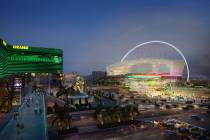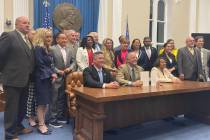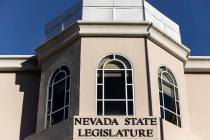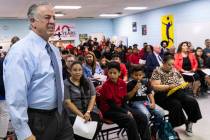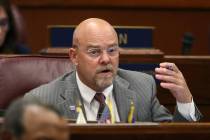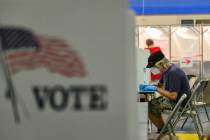Red-light madness
I was driving up Martin Luther King Boulevard the other day, right in front of the Metropolitan Police Department headquarters building, on my way back to the office after picking up some lunch.
Suddenly, the light at what’s called “Metro Plaza” turned red, and the four lanes of MLK traffic came to a halt in both directions.
I looked around to see if somebody was pulling out of the Metro parking lot. Nobody. Not a single car. After a short wait, the light turned green, and I drove on, wondering why in the hell the light had changed.
Welcome to Las Vegas. If you’ve been here for any significant length of time, you’ve experienced something similar. In fact, if you’re like me, you’ve probably got a whole list of spots where traffic gets stopped, screwed up or snarled, often for no apparent reason. If you don’t, I invite you to try my favorite example: Grand Central Parkway. It’s the street that passes directly in front of the Regional Transportation Commission’s headquarters, and it features nine ill-timed lights on a road just 1.1 miles long, or nearly one every 645 feet. You will never make it from one end to the other without stopping at least once, and sometimes many times.
So forgive me if I have a bitter laugh when the folks at the Regional Transportation Commission talk about their Big Ideas for fixing streets around town, including Maryland Parkway between McCarran International Airport and Sahara Avenue. If they can’t keep traffic flowing on regular streets, what makes anybody think they can untangle a complex mess elsewhere?
Sure enough, one of the leading ideas is to reduce the number of traffic lanes on the already-congested Maryland Parkway, so as to make room for light rail running down the center of the street. It seems to me that if you have congestion problems, you have too much demand (cars) and not enough supply (roadway), so reducing the supply without a concomitant reducing of the demand will actually exacerbate the problem.
Then again, they’ve already been hard at work ruining Maryland Parkway. At two places in front of UNLV, traffic planners have installed what they like to call “pedestrian-activated crossings,” where people on foot press a button, yellow LED lights start flashing, and cars stop while people cross the street.
Here’s the catch: Unlike regular signal lights, which allow people to cross for a specified period before allowing cars to proceed, there is no end to the amount of time a “pedestrian-activated crossing” can flash its yellow lights and require motorists to wait. A large enough crowd of UNLV pedestrians (say, at lunchtime), spaced strategically far enough apart can bring traffic on Maryland Parkway to a halt for several minutes, with no relief in sight. And motorists who get sick of waiting and gun it when there’s nobody directly in front of their vehicle (but while pedestrians are still in the street) can be stopped and ticketed.
This isn’t theory; I’ve personally witnessed all of the above happen.
Now, perhaps my conspiracy theory is undercut by the facts: Could the same people who can’t keep traffic flowing while lights turn green for phantom cars really be diabolical enough to devise a plan to render Maryland Parkway so useless that drivers simply throw up their hands, yell a profanity and find an alternate route, allowing them to install their pretty trains without protest? Seems unlikely, but I’m still suspicious.
The bottom line is this: Before the RTC and its partners dream of whisking people from the airport to the Strip, downtown and the university district on clean-energy-powered light rail with free WiFi, maybe we should ask them to first demonstrate they can synchronize traffic signals on major roads? Or devise solutions that accommodate both drivers and pedestrians, without clearly favoring one over the other?
If that happens, let me know, and I’ll be more than happy to endorse the RTC’s plans. Until then, I’ll probably be waiting at a red light somewhere.
Steve Sebelius is a Las Vegas Review-Journal political columnist who blogs at SlashPolitics.com. Follow him on Twitter (@SteveSebelius) or reach him at 702-387-5276 or ssebelius@reviewjournal.com.








